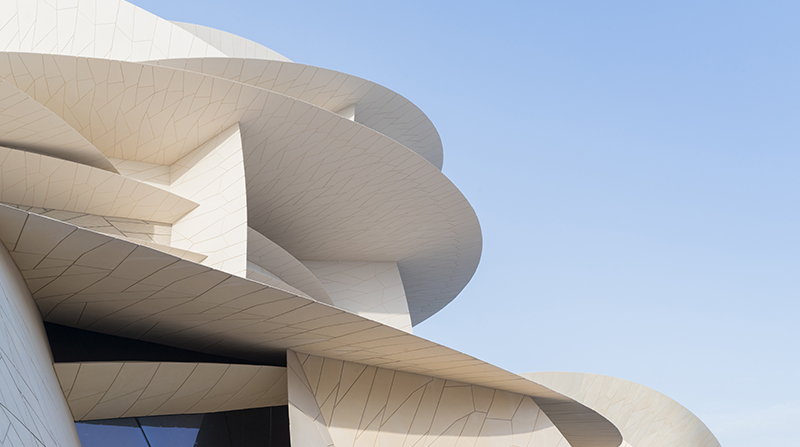
The National Museum of Qatar opened in a blaze of publicity and local pride in late March. Housed in one of the most architecturally lauded buildings of recent times, the NMoQ (as it’s informally known) traces the history of the tiny Arabian Gulf country from its distant prehistoric past to its glittering present and future as host of the 2022 FIFA World Cup.
Here are five reasons why you should be adding this newly opened icon to your Doha itinerary.
The architecture
Designed by Jean Nouvel, the Pritzker Prize-winning French architect behind the Louvre Abu Dhabi, the structure is inspired by a desert rose — a flower-shaped crystal cluster naturally formed by the arid region’s winds.
Occupying 430,000 square feet, the building is all curves and has been designed to take into account Qatar’s fierce summer climate, which regularly sees temperatures soar more than 100 degrees Fahrenheit. The shadows created by overhanging discs allow you to stroll around outside while also protecting the interior from light and heat.
Blending old and new, the venue also encompasses the recently restored Palace of Sheikh Abdullah bin Jassim Al-Thani, the site of the original National Museum named for one of modern Qatar’s first rulers. The interior has no straight walls, so the exhibits are creatively displayed — some seemingly suspended in thin air.
The exhibits
Even though it didn’t officially declare independence until 1971, Qatar has a rich and fascinating history. NMoQ’s exhibits are organized in three chapters — Beginnings, Life in Qatar and The Modern History of Qatar — that capture as much of this legacy as possible, from prehistoric origins to its growth from a handful of fishing and pearling villages to becoming one of the world’s wealthiest nations.
Star items include the stunning Pearl Carpet of Baroda (believed to have been commissioned to shroud the Prophet Mohammed’s tomb), which is hand-embroidered using 1.5 million pearls, sapphires and diamonds; meteorites that crashed in Qatar’s vast desert; and a striking sculpture by Chinese artist Ai Weiwei symbolizing the decline of the country’s pearl-diving industry.
Children are not forgotten — each gallery has an interactive element to engage tiny travelers.
The gift shop
Continuing the desert theme, NMoQ’s gift shop was inspired by local natural landmark Dahl Al Misfir (“Cave of Light”), where the famous rose-shaped crystals are commonly found.
The stunning space was constructed from more than 40,000 wooden beams that form an undulating, three-dimensional puzzle. The brainchild of Sydney-based architect Koichi Takada, each piece is unique and fits only with its exact counterpart.
Browse the shop’s collection of eclectic wares with a touch of whimsy, including hand-crafted jewelry replicating the desert rose and Russian nesting dolls in Qatar’s national dress. A must-buy is an actual desert rose — the stones are available to purchase in three luggage-friendly sizes.
The films
The multi-sensory museum commissioned some of the world’s best-known directors to bring even more life to its exhibits. Each film is displayed on a soaring interior wall of the building, giving you the chance to be fully immersed in the experience.
Mauritanian director Abderrahmane Sissako examines the country’s Bedouin people and their seasonal journey from Al Barr (“the desert”) to the coast to find water, seek pastures and exchange their goods.
Girl with a Pearl Earring director Peter Webber turns his lens onto the battle that led to the unification of tribes to create Qatar. Without dialogue and with only ambient sounds, the production is both evocative and educational.
Displayed on two 101-foot screens, Queen of Katwe director Mira Nair’s film is an unflinching look at the physical and emotional hardships of the pearling industry that sustained Qatar’s fledgling pre-oil economy into the 20th century.
These works are supplemented by recorded oral histories of the Qatari people, telling stories from their past as well as focusing on traditions and family culture.
The food
As with the exhibits, much thought also has gone into the culinary offerings at the museum.
Operated by famed Qatari chef Nouf Al Marri, the ground-floor Desert Rose Café features some of the country’s most-loved dishes, like balaleet (a sweet and savory dish of vermicelli noodles and honey) and shakshouka (poached egg in tomato sauce) given the toque’s touch with fresh cheese and chilies.
Privé by Sara Al Sayyed may be housed in a small kiosk on the museum grounds, but what it lacks in size it makes up for in flavor. Housemade selections include the namesake chef’s famous bakery items, like decadent salted caramel brownies, handmade cereal bars and some of the best smoothie bowls in the city.
Café 875, on the mezzanine level of the Museum building, is inspired by Qatar’s traditional gold jewelry — 875 is an exceptionally high grade of the precious metal’s purity. The venue also brings Bedouin elements into its design, like black-and-white Sadu woven patterns.
Coming soon is a fine-dining concept, Jiwan Restaurant. The fourth-floor venue’s name means “perfect pearl,” illustrated by the more than 4 million ivory-hued crystal beads adorning the interior.
